Joe Scally is an 18-year-old full-back currently playing for Borussia Mönchengladbach in the Bundesliga. The young American joined Mönchengladbach for a £1.62 million fee in January of 2021, joining from New York City FC of the MLS, where he had come through the youth academy before signing a professional contract at the age of 15.
Scally has managed to force his way into the Mönchengladbach starting XI, all this despite competing with Stefan Lainer and Ramy Bensebaini on each flank – two full-backs of the highest calibre and with plenty of experience. Injuries have certainly helped Scally get into the line-up more regularly, but he has earned the right to be there, as his performances have shown.
And yet, a senior international call-up for the USA national team still eludes Scally. Antonee Robinson, Sergino Dest, Shaquell Moore and George Bello have played in the full-back positions in their most recent fixtures – and whilst they all have quality, the only other player to be regularly starting for a top-level side in one of Europe’s top five leagues (like Scally) is Dest (with Barcelona). Nevertheless, it feels like a matter of time before Scally is called up, particularly given such a positive start to his 2021/22 season.
This tactical analysis and scout report will provide an analysis of Scally’s attributes and performances, and how he fits into Mönchengladbach’s tactics.
Position
Firstly, it needs to be asked whether Scally is a right-back or a left-back. He is right-footed but is very comfortable with his left. This season Scally has played almost equal minutes in both. He has played solely on the right side in two fixtures, and solely on the left in two fixtures. However, other than in these games, in his other five appearances at the time of writing, he switched between positions.
Looking at his heat map from this season we can note a few potential tendencies from each position. He takes possession in deeper areas more frequently when playing on the left, and either cuts inside or drifts into a slightly more narrow position. As he enters the opposition half he also looks to cut inside onto his right foot a fair amount too. On the right flank there is more action inside the opposition half and far more action still on that flank but closer to the opposition 18 yard-box.
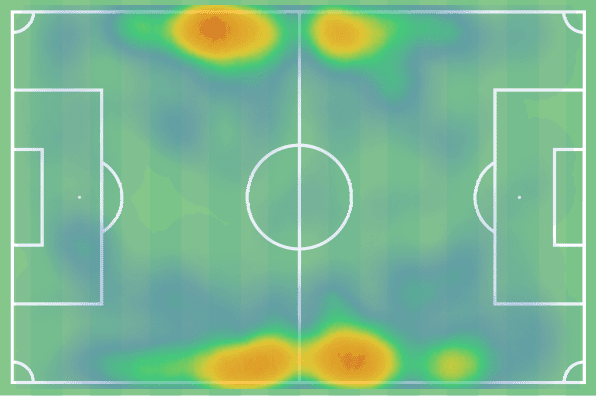
Defensive work
Defensively, Mönchengladbach haven’t been overly outstanding, but other than their 4-0 drubbing at the hands of Bayer Leverkusen they haven’t had many bad days at the office. They have conceded 11 goals in the league and have an expected goals against of 11.6, so are performing as they are expected to. Scally has performed well enough defensively, and a glance at his metrics shows that he is doing fine, but is on the lower side of win percentages for the two key metrics: defensive duels and aerial duels. Scally has won 58.7% of his defensive duels so far this season, and 53.3% of his aerial duels. At 1.84m in height, Scally is tall for a full-back, and should certainly be performing slightly better aerially.
The graph below looks at his defensive duel data in relation to the rest of the Bundesliga’s full-backs who have played at least 300 minutes of football this season.
Whilst his win percentage is below the league average, it is encouraging to see that Scally is at least a very active defender, with few full-backs in the league competing in more defensive duels per 90 than he does. Competing in such a high number isn’t always conducive to having a high win percentage, so that would explain a slightly lower than average win percentage, with other defenders like Benno Schmitz, Josko Gvardiol and Josip Stanisic suffering a similar fate.
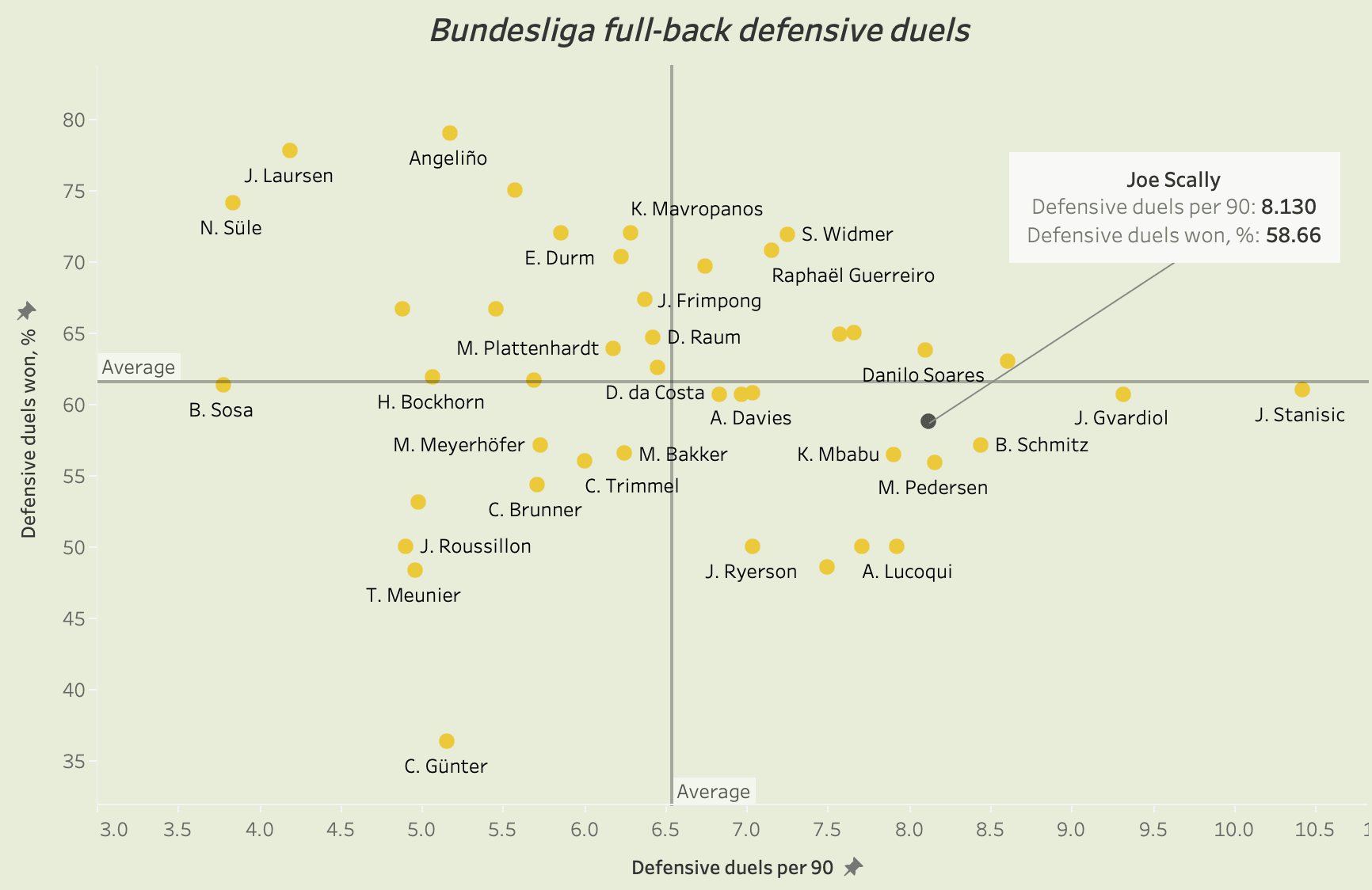
Scally’s higher defensive duel volume may be partly down to his active role in stepping forward to press in some phases of the game. When looking to pin an opponent back, like from a throw-in inside their own half, then Scally is likely to push forward. If operating as a wing-back he will also be more aggressive in the pressing phase. Scally does a good job of closing the space quickly whilst decelerating if there isn’t a clear chance to win the ball, preventing himself from being beaten too easily with a dribble.
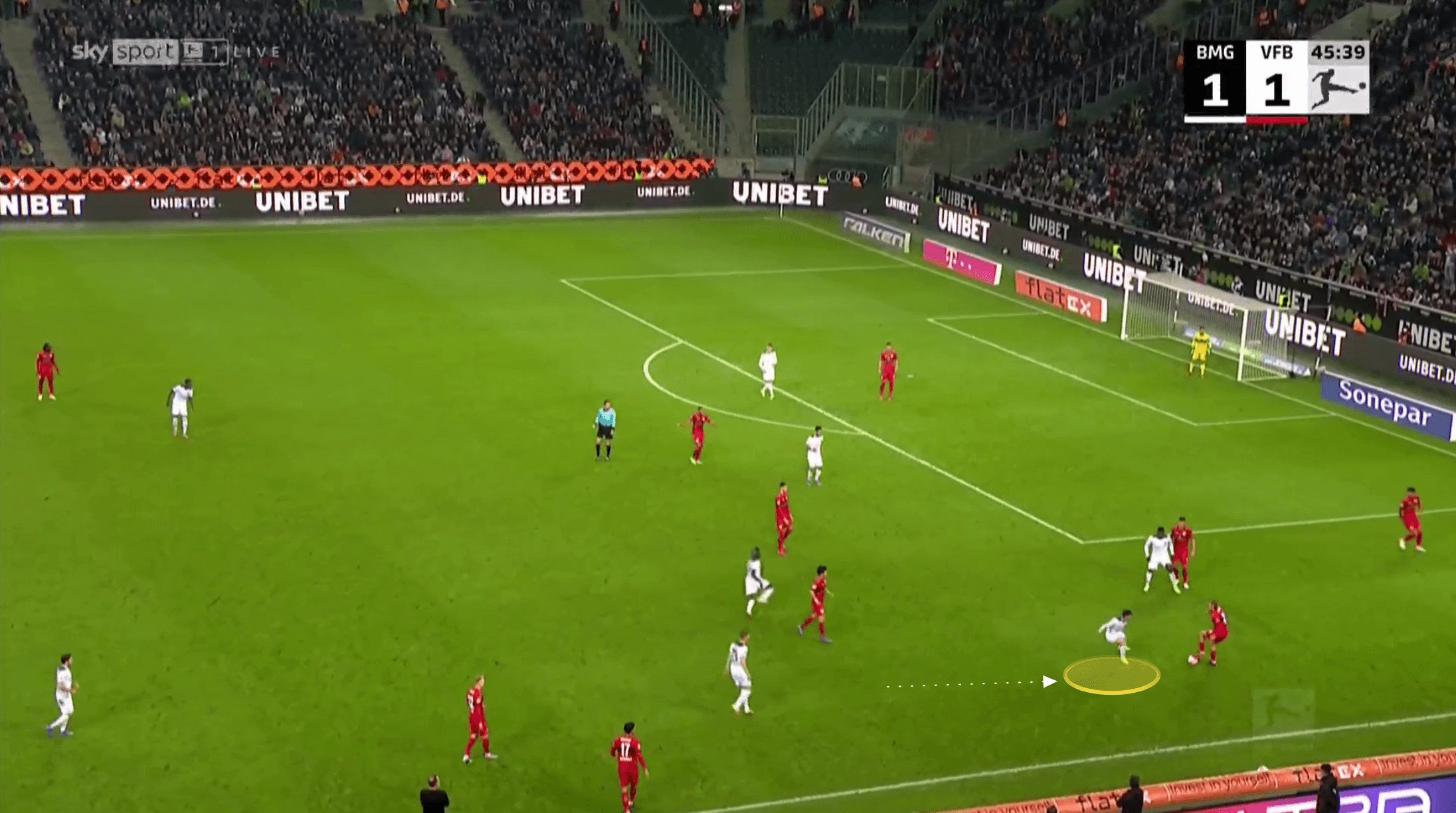
His body positioning can be a touch flat at times, however. Scally can get drawn forward slightly in a 1v1 defensive duel, and whilst he might initially start in a side-on position, he can bring his back leg forward if the ball-carrier feints to move the other side. We can see this occurring in the next image. Fortunately, Scally has good recovery pace, and rarely gets completely beaten in such a situation, often recovering to pressure the ball-carrier and prevent an easy cross at the very least.
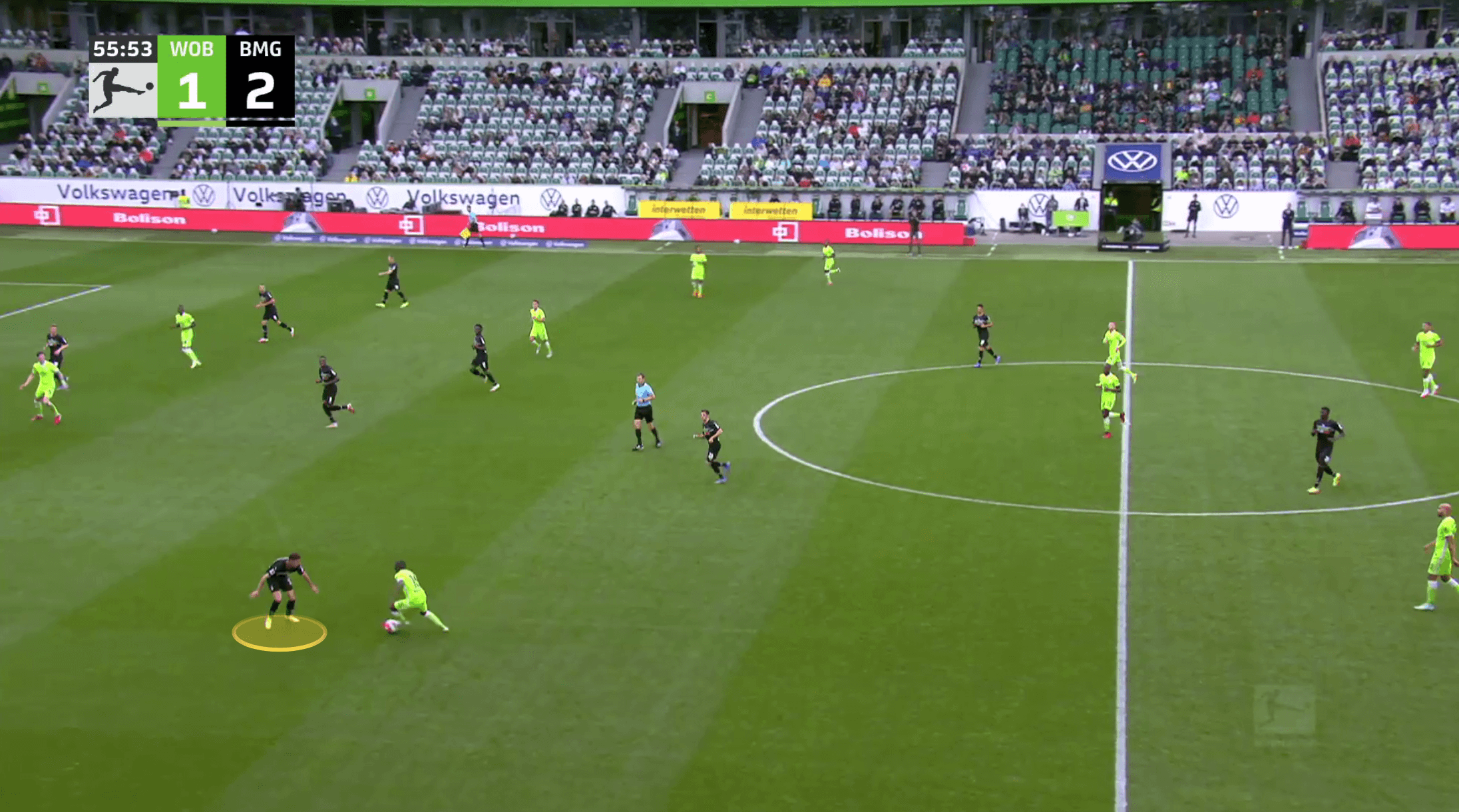
He could make a higher number of blocks from such instances though, often running with the ball-carrier and putting pressure on them, but allowing them to cross too often regardless. Scally has averaged just 0.12 blocks per 90 this season.
He does have a tendency to rely on his recovery pace a little too much at times, showing a reactive rather than proactive approach to his positioning in some cases. He can allow an opponent to gain a few yards on him, like in the image below, when an attack is occuring on the opposite flank. Whilst he can recover in these instances, he often has to make a late sprint to get into position rather than doing the work early and taking a settled defensive position before the cross comes in.
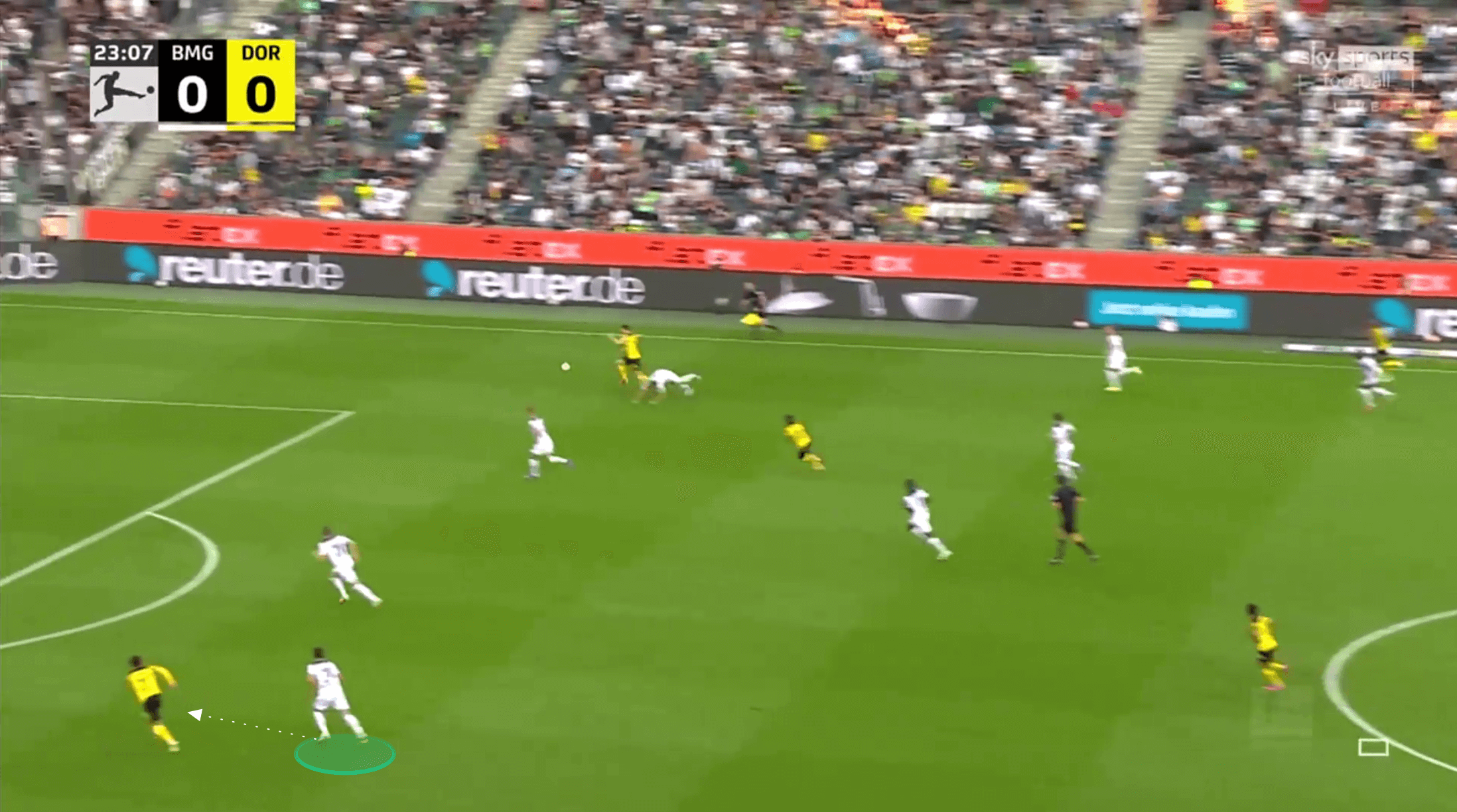
Passing and decision-making
Scally’s two-footedness makes him a difficult player to press, and he can pass accurately and break lines with either his right or left. As a left-back for example, if pressed and shown inside, Scally is shown onto his favoured right foot and he can play through a congested central channel to still break lines and find a teammate. If shown down the outside instead, he is still confident with his left and may find a pass in such an instance, or may progress the ball with a dribble if afforded space. It makes him a difficult prospect to set up to press against.
As such it’s unsurprising to see Scally perform well for progressive pass accuracy. Whilst his 7.97 progressive passes per 90 is below the league average, his 82% completion is outstanding.
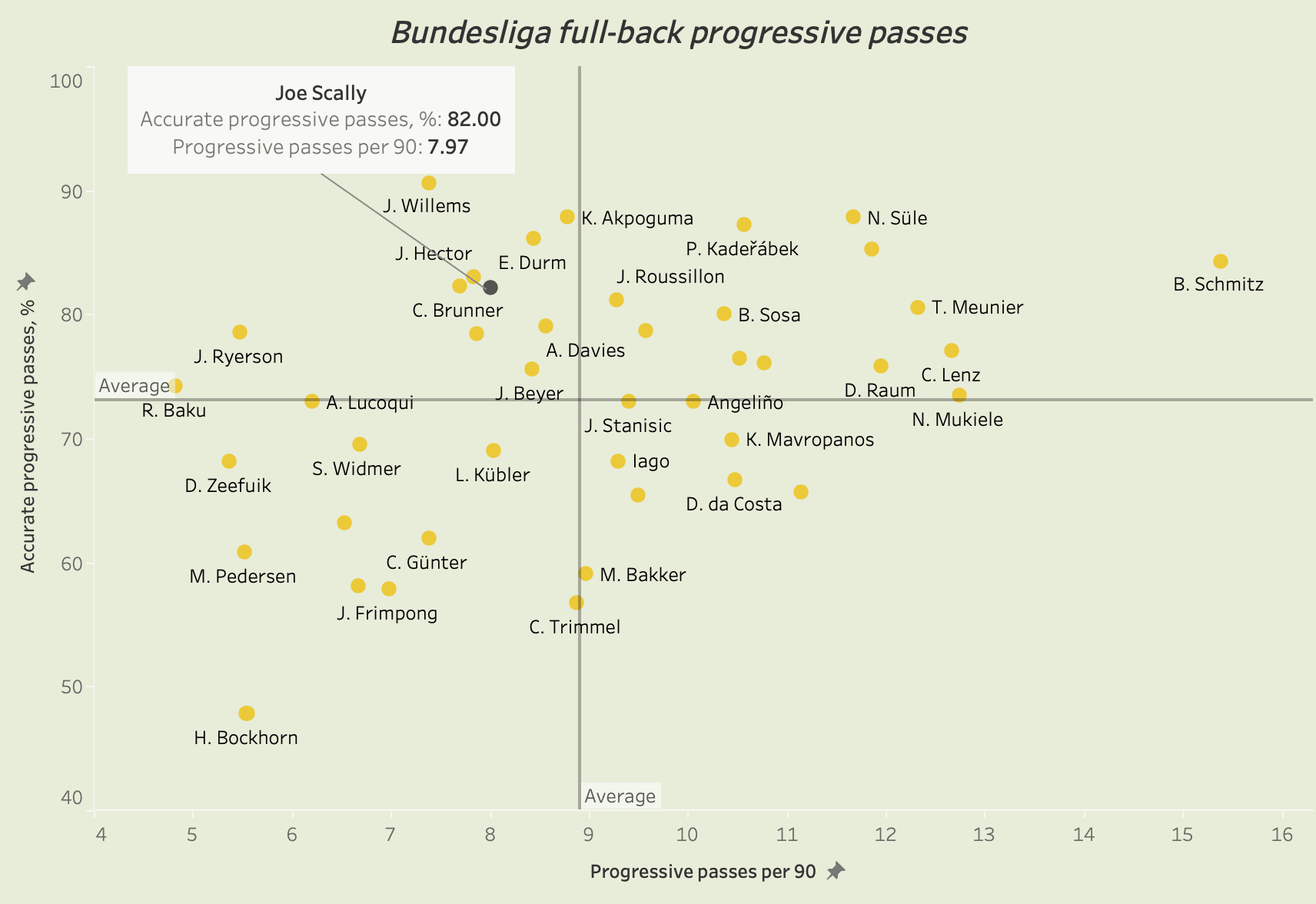
Scally makes his passing decision-making quickly and shows good awareness of the positioning of players ahead of him to release them with through passes. Below is such an example, where he receives possession under considerable pressure and on his second touch is able to find a pass down the line.
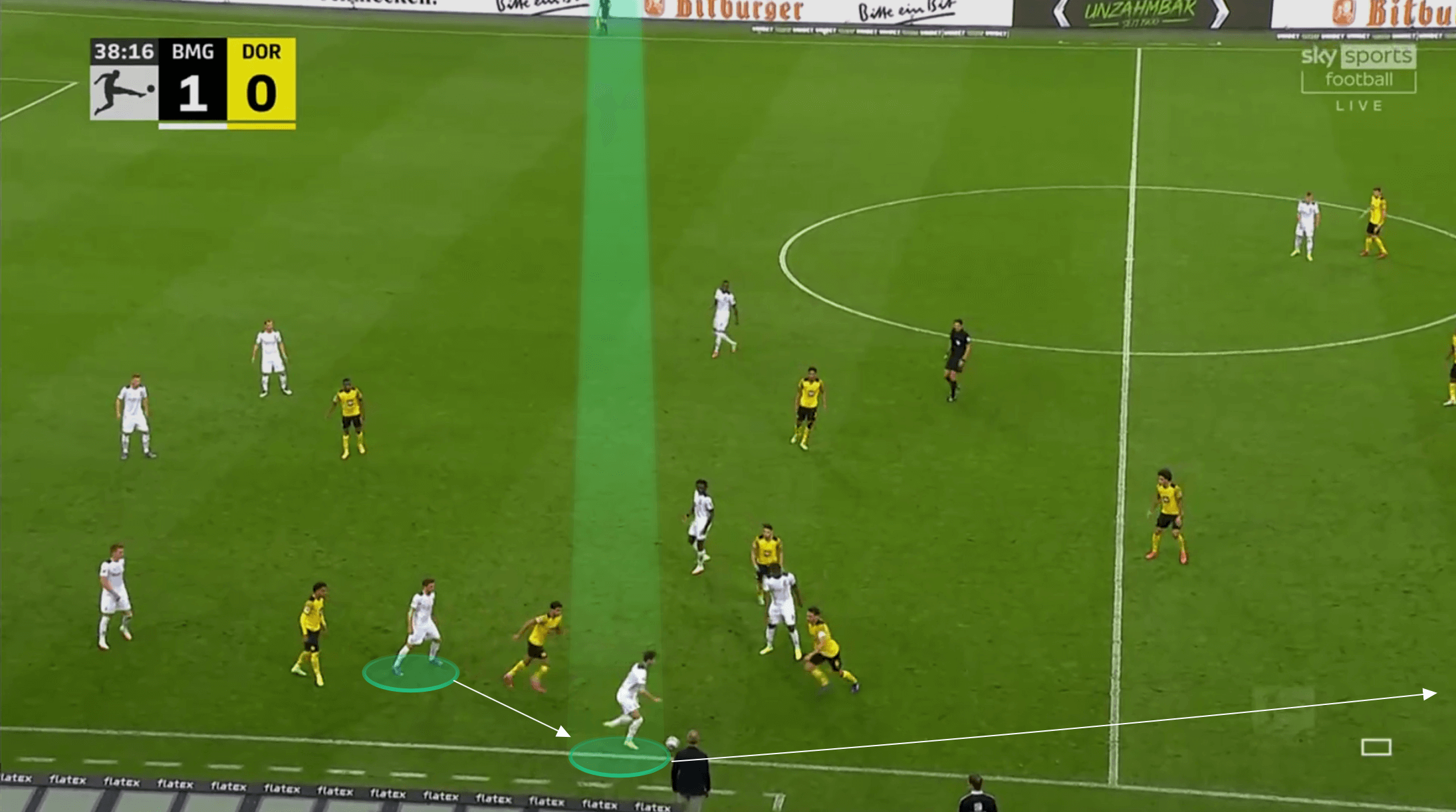
Rather than just being a simple clip down the line, Scally in fact released one of his attackers into the space behind.
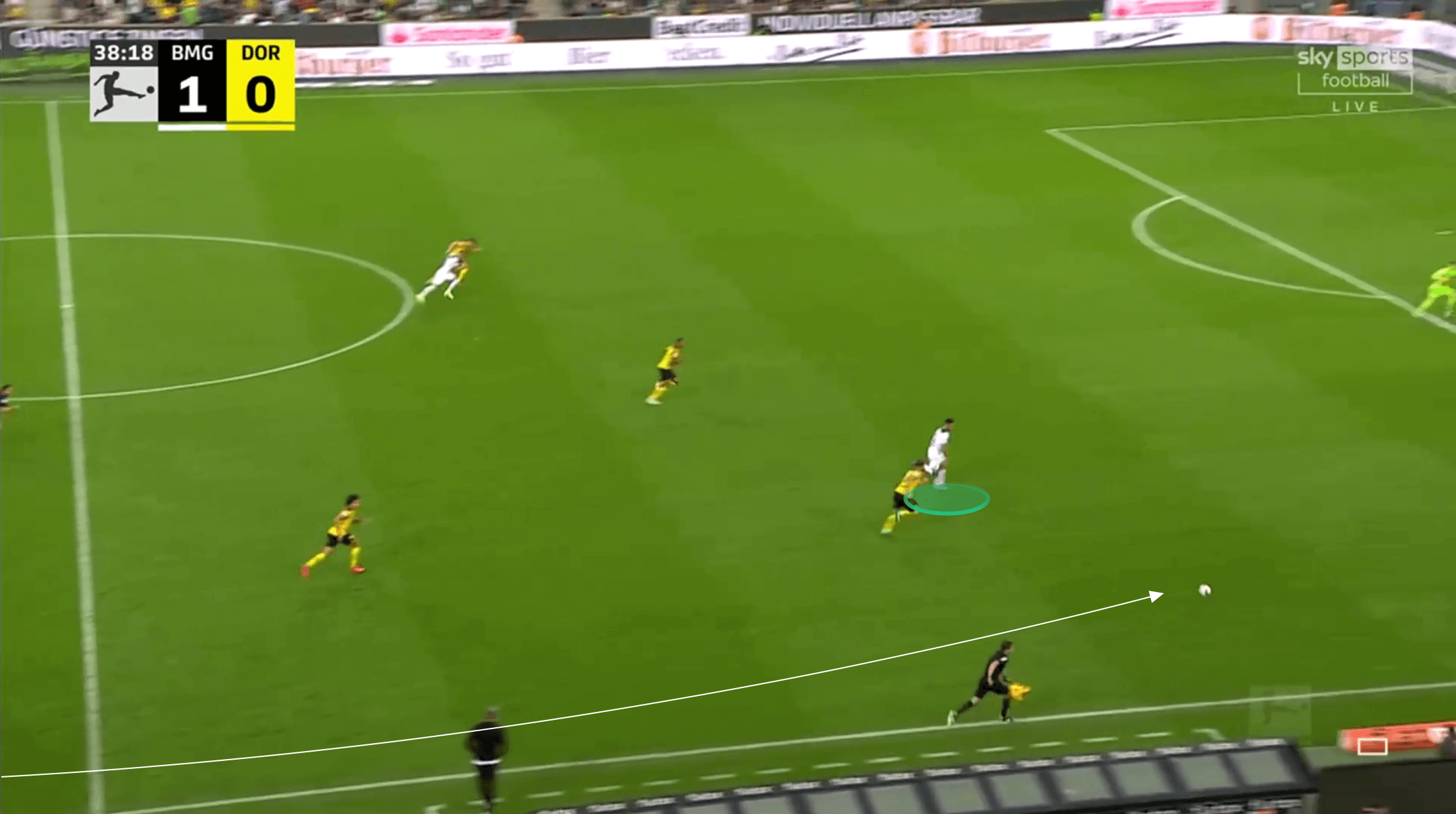
He has range to his passing too, and is confident taking on more difficult long passes. In fact, if compared once more to other full-backs in the league we can see that Scally is very accurate with longer passes, despite having one of the longer average long pass lengths in the league. He makes an average amount of long passes per 90, but his 69.2% completion on these passes is impressive.
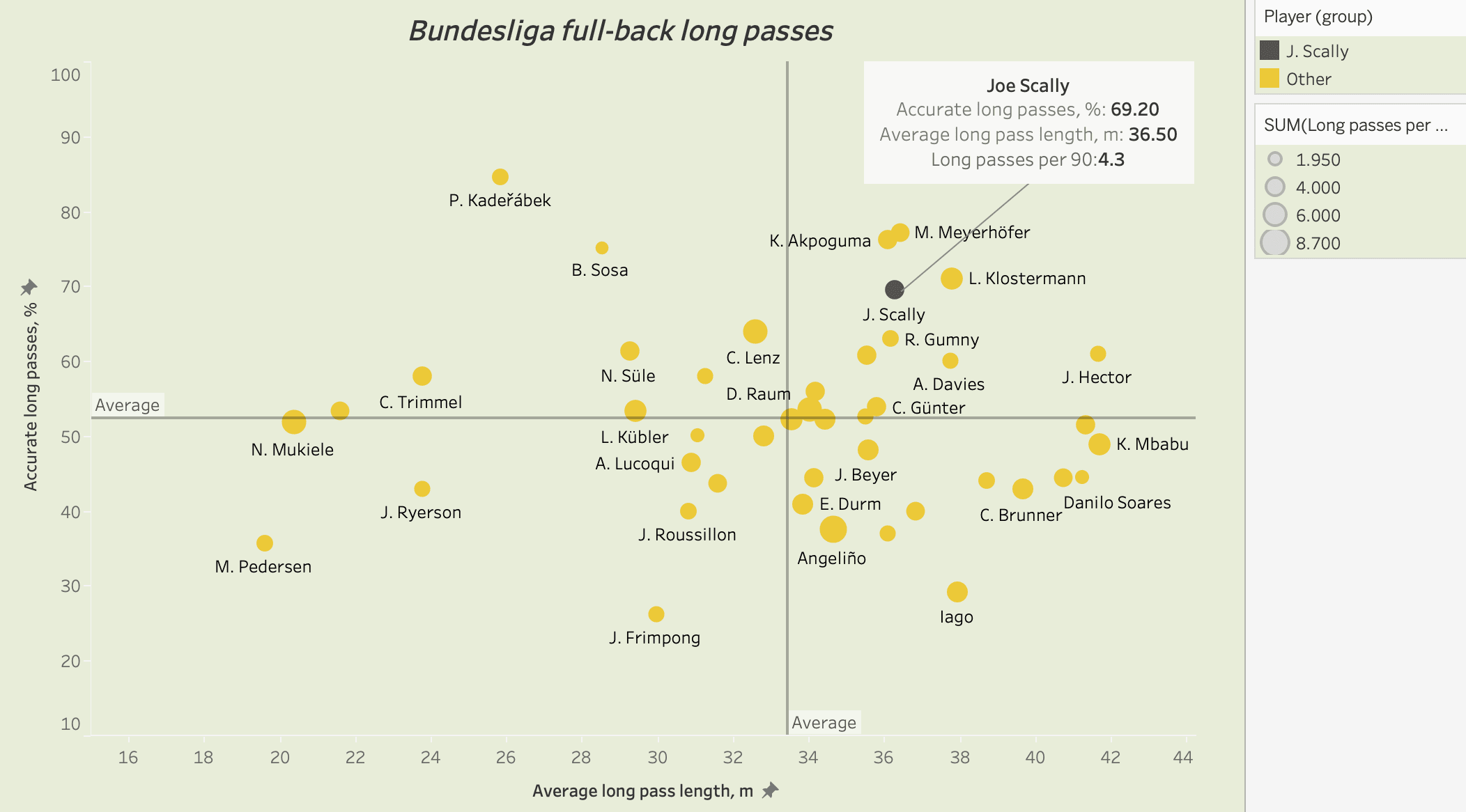
These passes can be balls hit down the line, or diagonal passes hit towards the opposite flank from a deeper area, but he also uses them in the final third. Scally has been seen lofting the ball into the area from 30-40 yards out from goal, but he can also hit a switch of play to release the winger or full-back on the opposite flank, as we can see occurring in the image below.
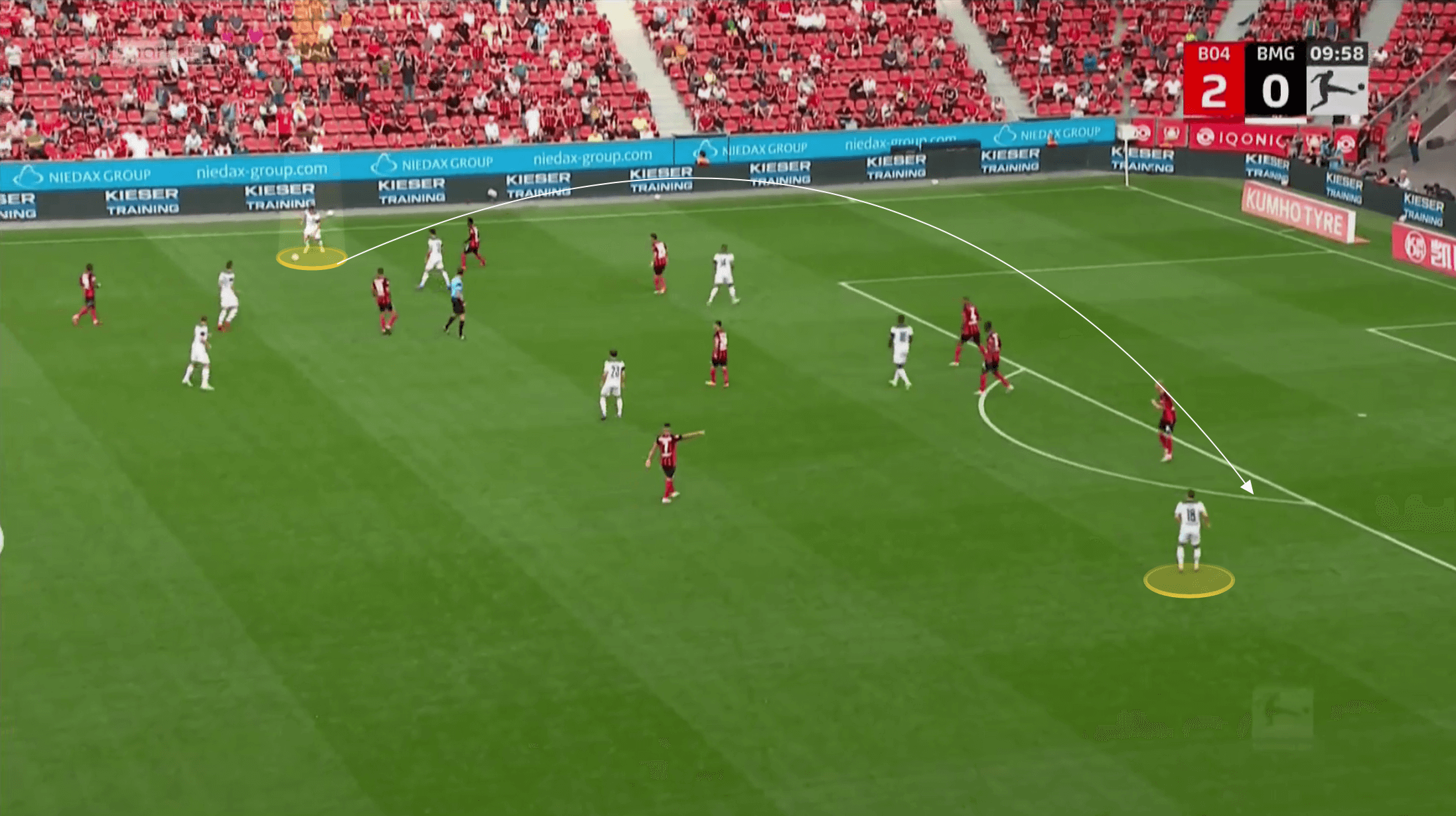
Scally’s ability to receive with correct body shape and frequently scan helps him have such a high forward pass accuracy. Before receiving the ball Scally looks to open his body up to receive on the half-turn and scans at the very least once, but often two or three times before getting on the ball. In the next two images, Scally receives on the half-turn on attacking transition. In the first image, he scans to check for pressure as the ball is played out to him.
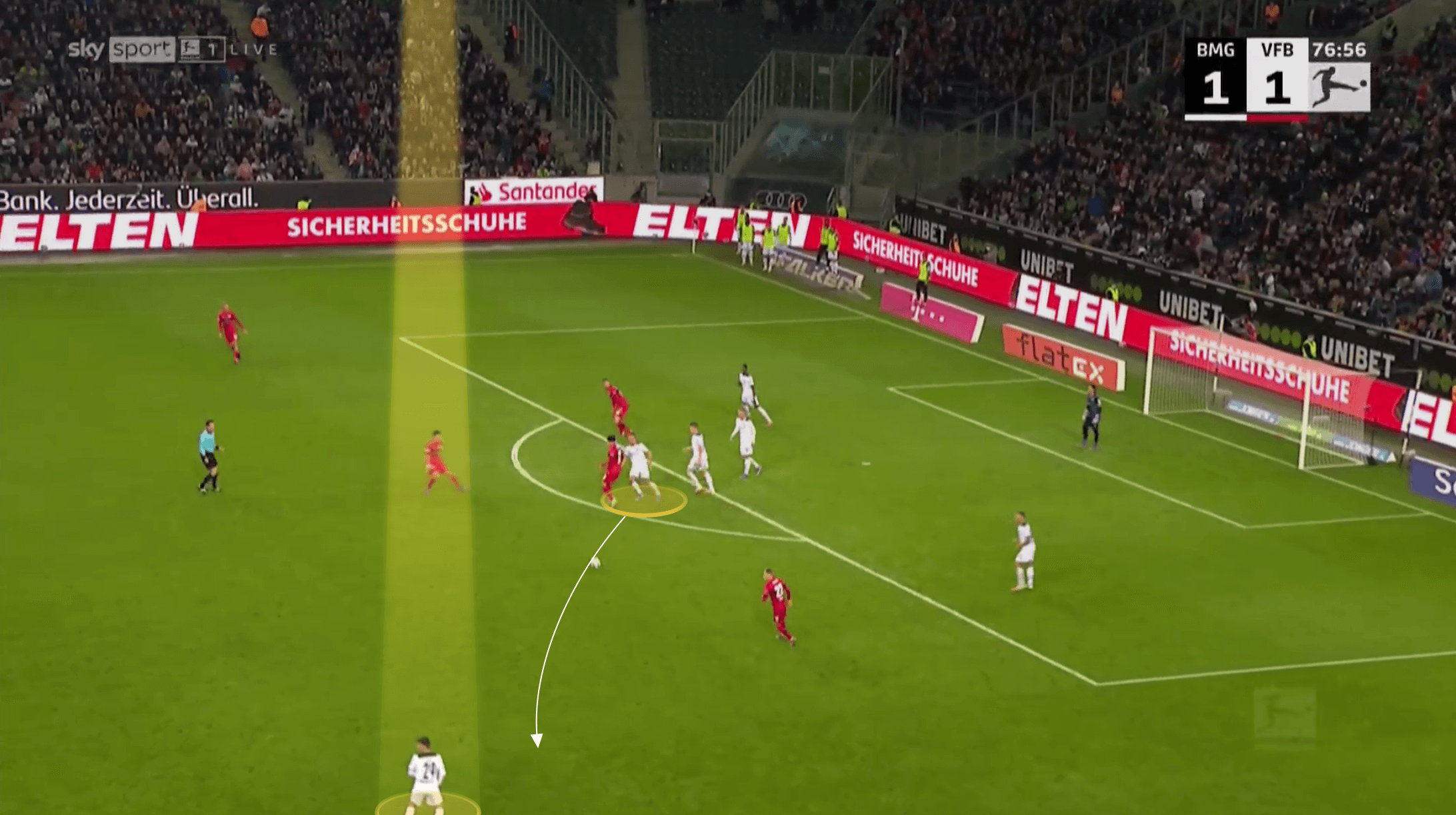
Seeing he is in space, Scally then scans a second time, looking for the pass option as the ball gets even closer. It’s worth noting that these two scans occur within a split second of one another.
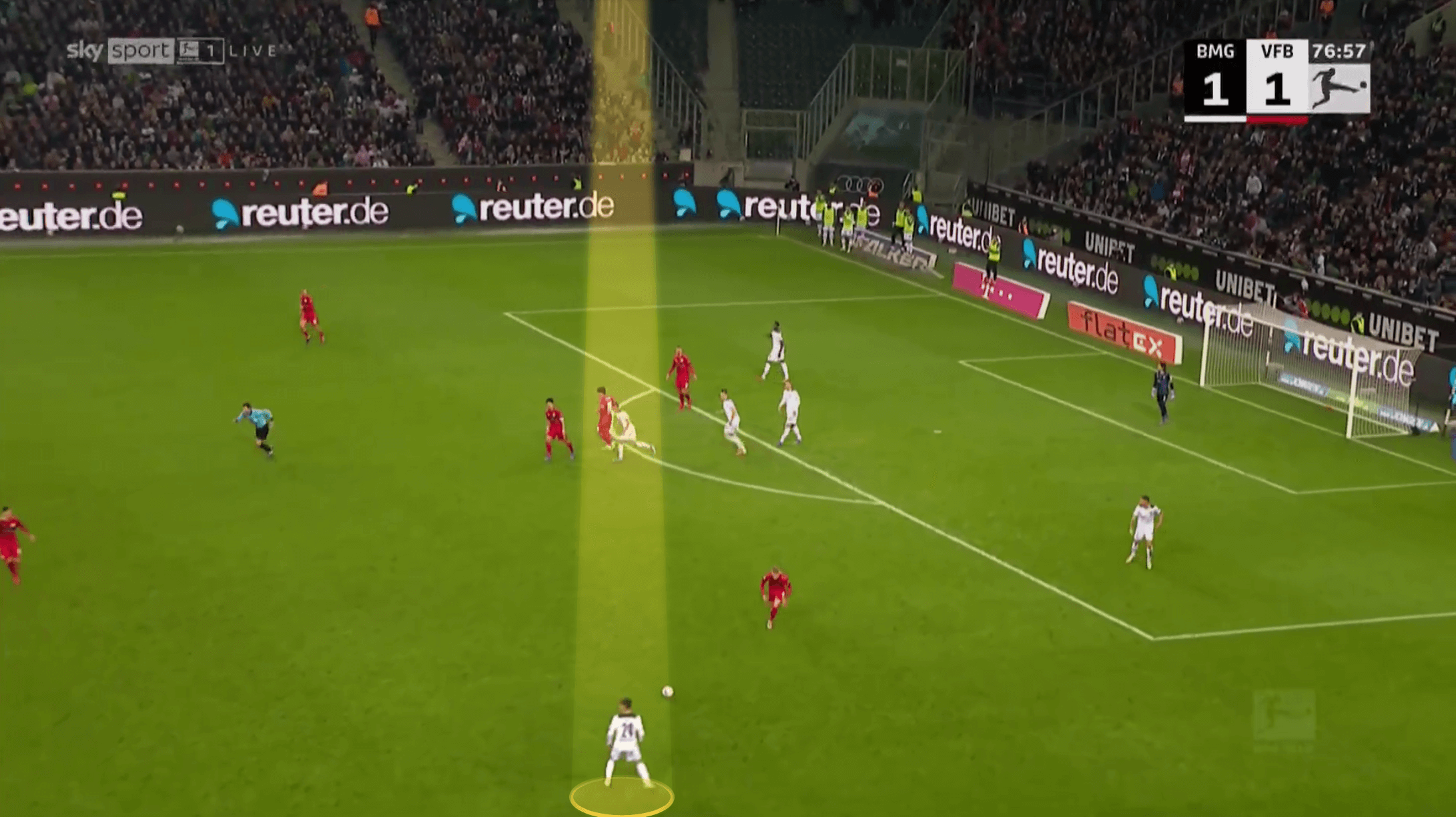
As a result, he is able to take a touch and quickly find a forward pass option, playing an impeccably well-placed ball into the highlighted attacker, missing out the defender positioned just in front of them.
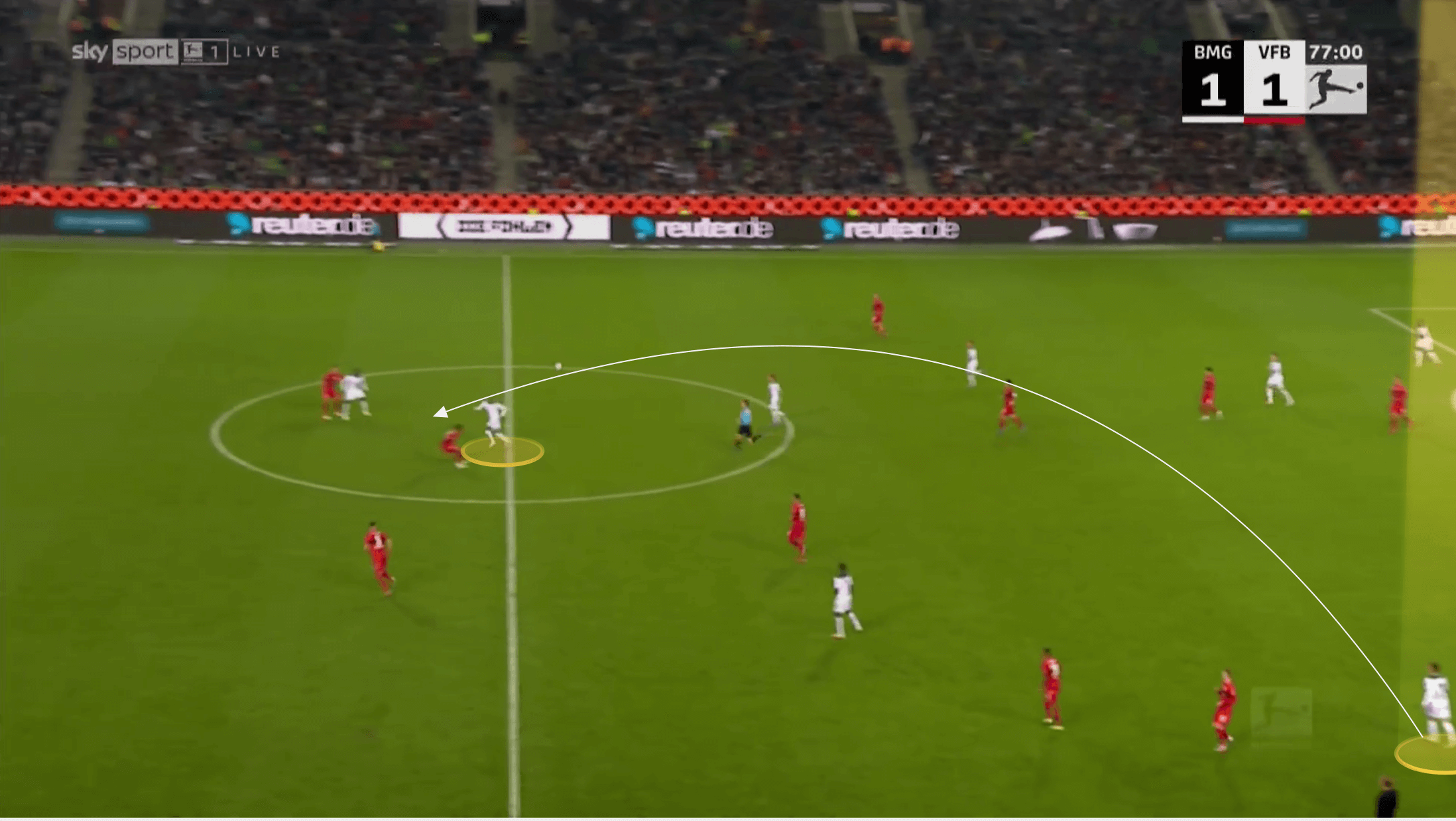
Attacking output
Scally’s crossing data also shows us that whilst there isn’t a particularly high volume of crosses occurring, he is still completing a significant portion of these. His 40.11% completion on his crosses is very strong.
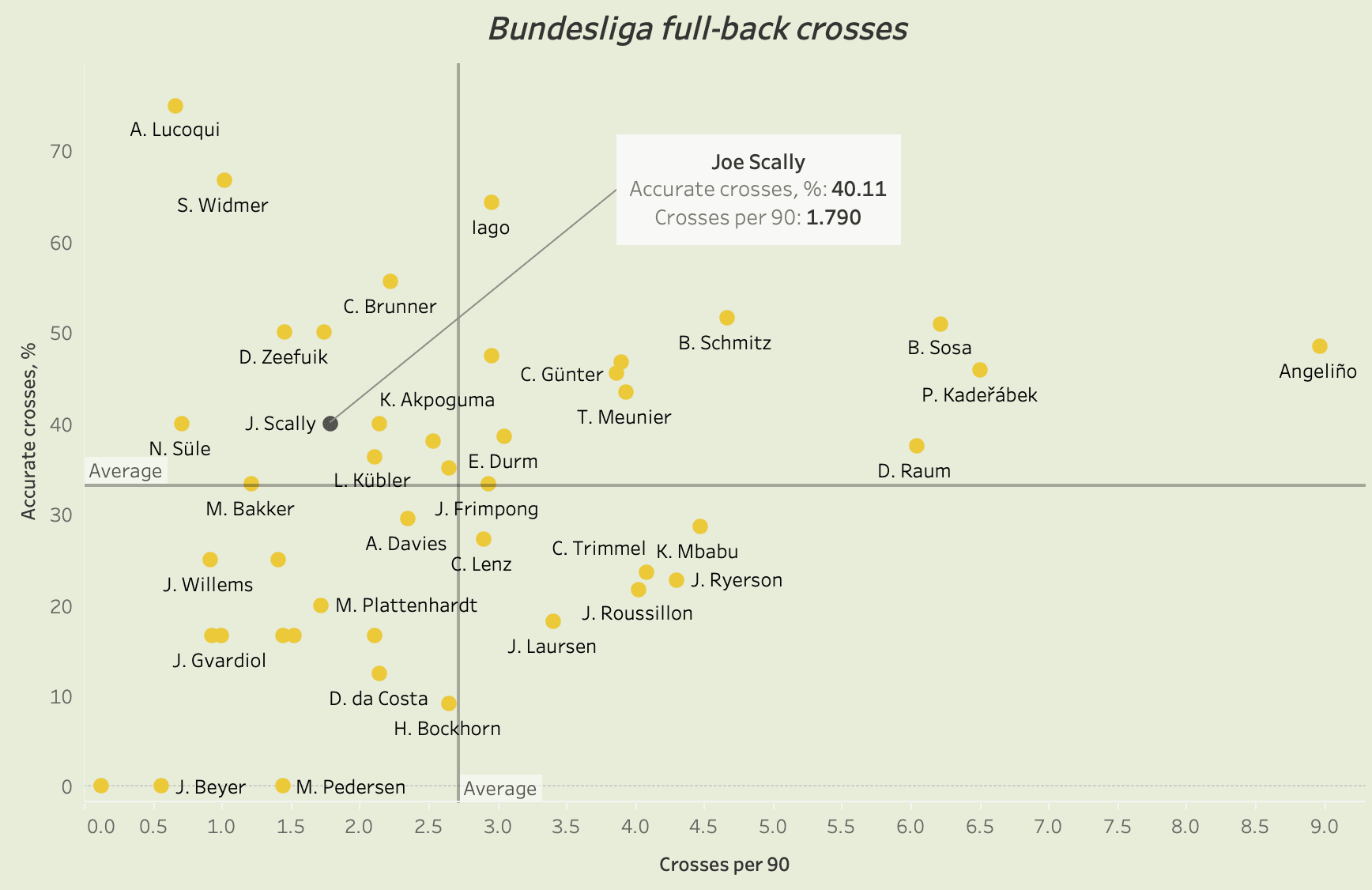
Scally doesn’t always take a high position down his flank but at times can be seen over-lapping and providing relief for a congested central channel.
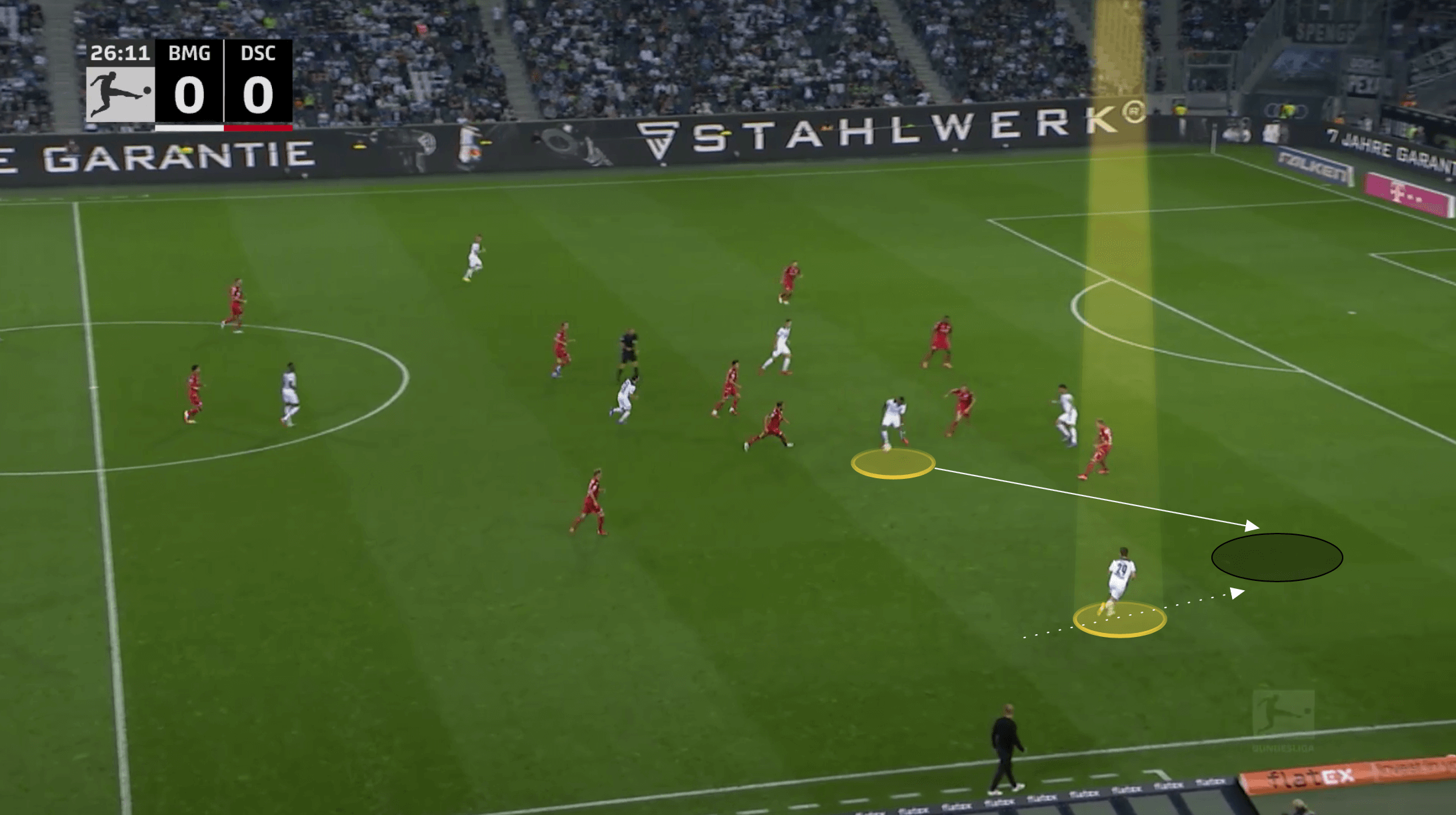
If found in such an area and with space in behind to attack, Scally can direct an accurate cross behind the high line of the opposition defence for his teammates to run onto to attack.
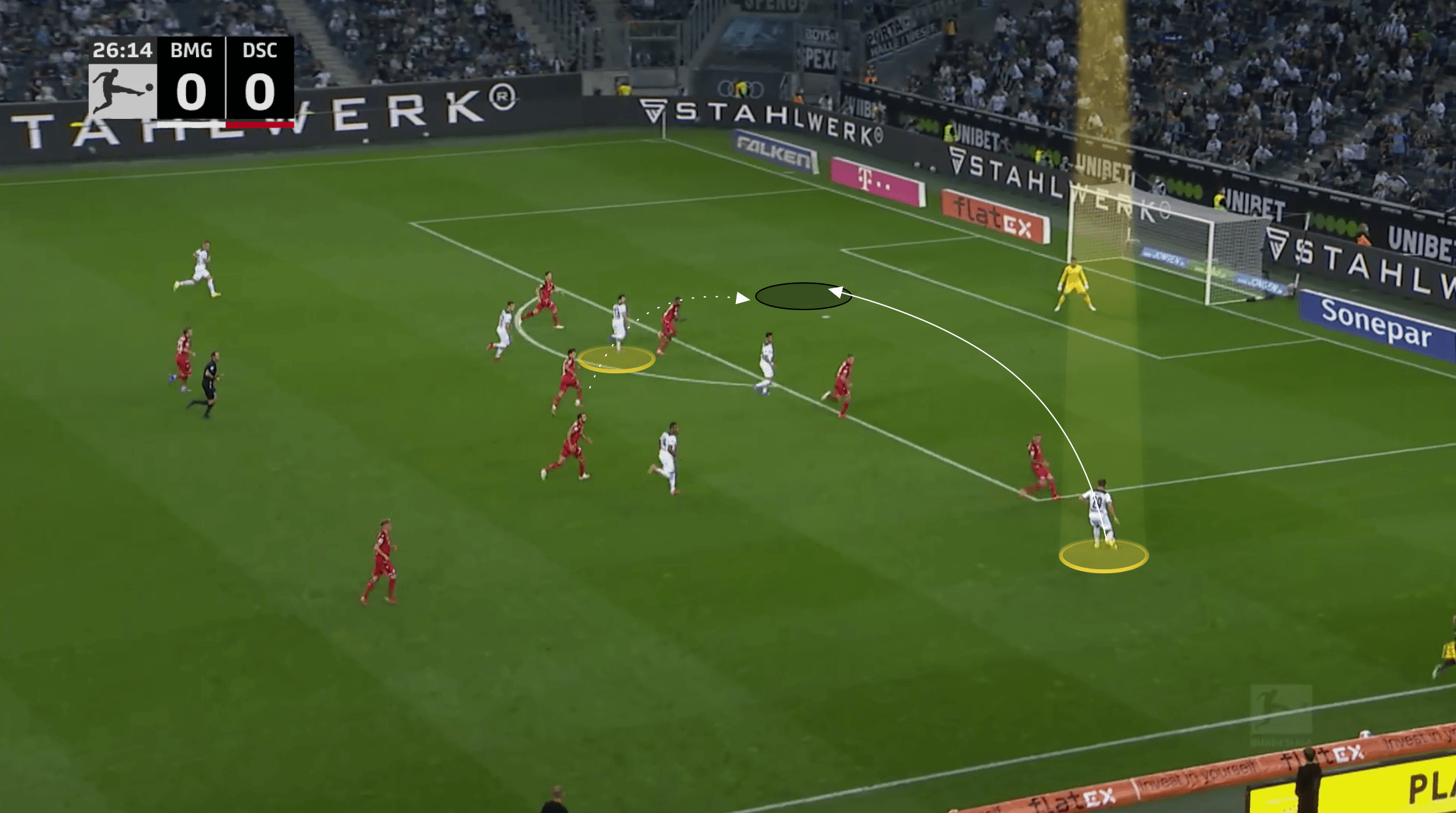
Whilst this is the general sort of position Scally will look to cross from, it isn’t the most common technique. Scally mostly looks to angle a ball into the box near the penalty box, most often at head height. These crosses can lack danger at times, but nevertheless, are likely to be more accurate given it is less crowded due to its distance from goal.
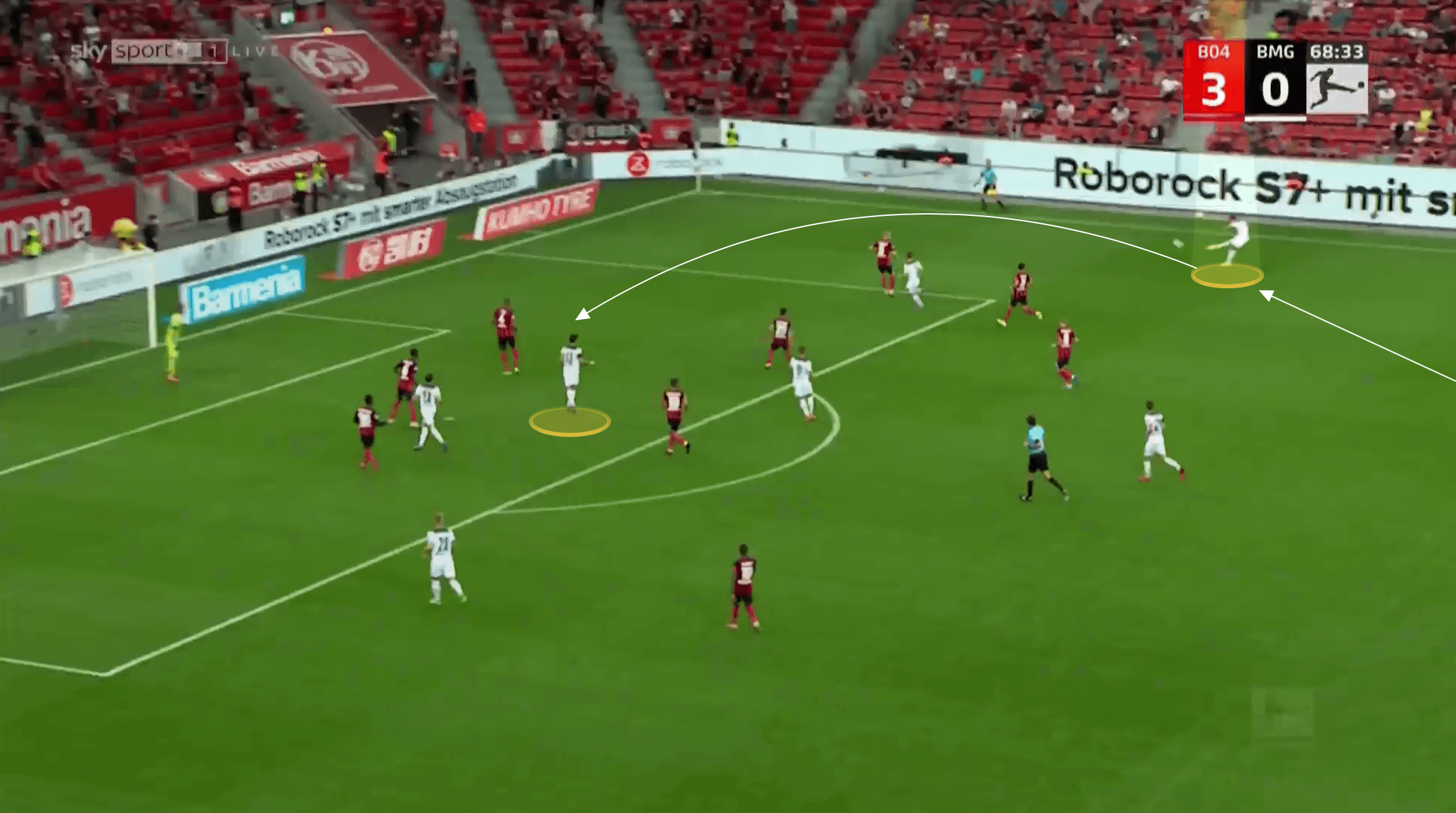
He does have a slight tendency to overhit some crosses as well, and funnily enough, these crosses that overrun are often recovered by his teammates, and so go down as an accurate cross – one of the pitfalls of data without context. These crosses don’t come from him striking the ball too hard per se, but rather from Scally getting under the ball too much, as seen in the following image.
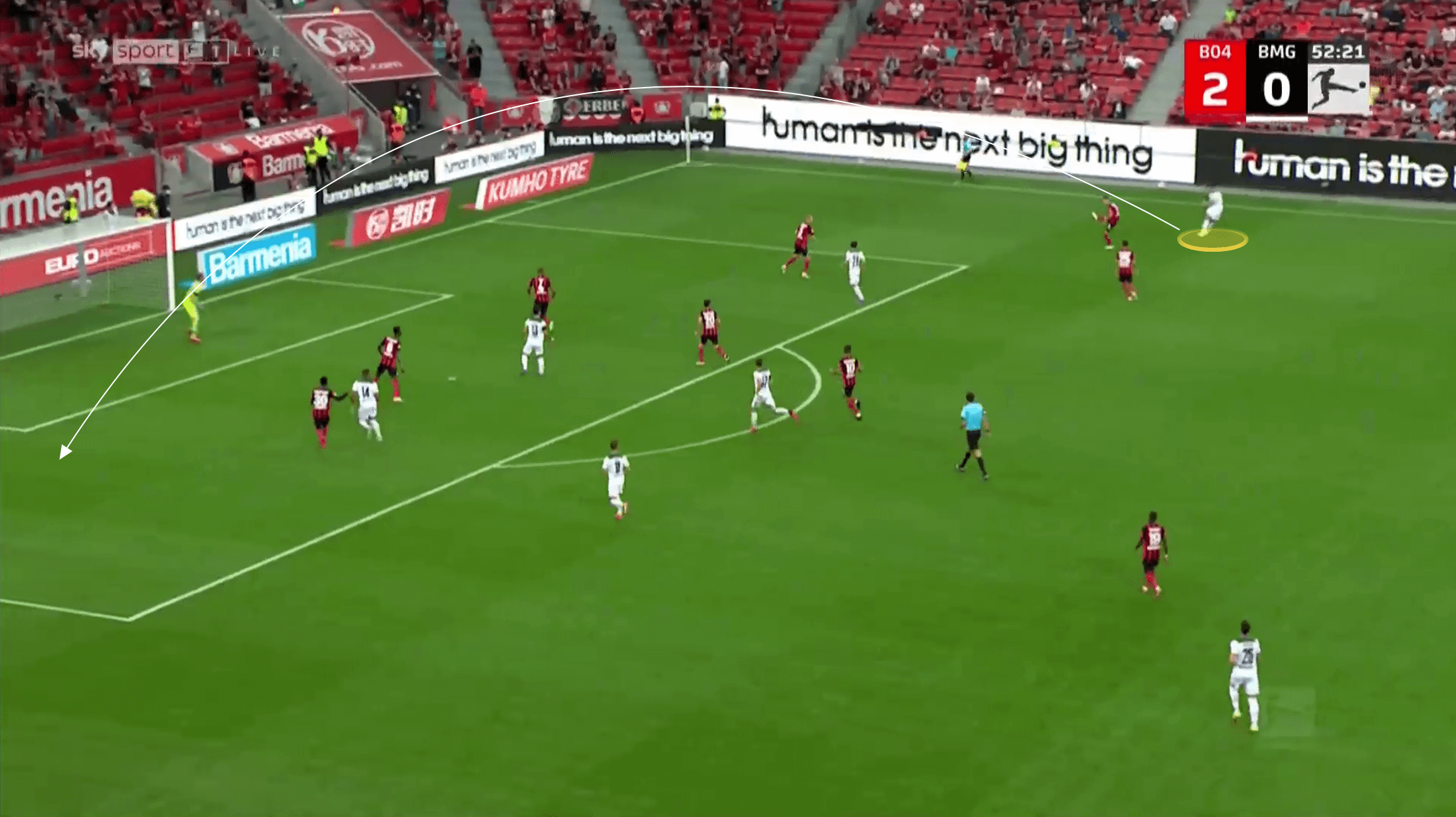
Scally has ability as a dribbler but has only completed 36.1% of his dribbles this season. He has averaged 4.3 dribbles per 90 which is relatively high and is confident taking players on. He might ignore an easy pass to take on a dribble, like in the image below where he decides to drive down the line instead of finding the free man inside. This shows a lack of consistently good game-reading, and in this example, though he beats the first man, he runs directly into the opposition right-back and loses possession.
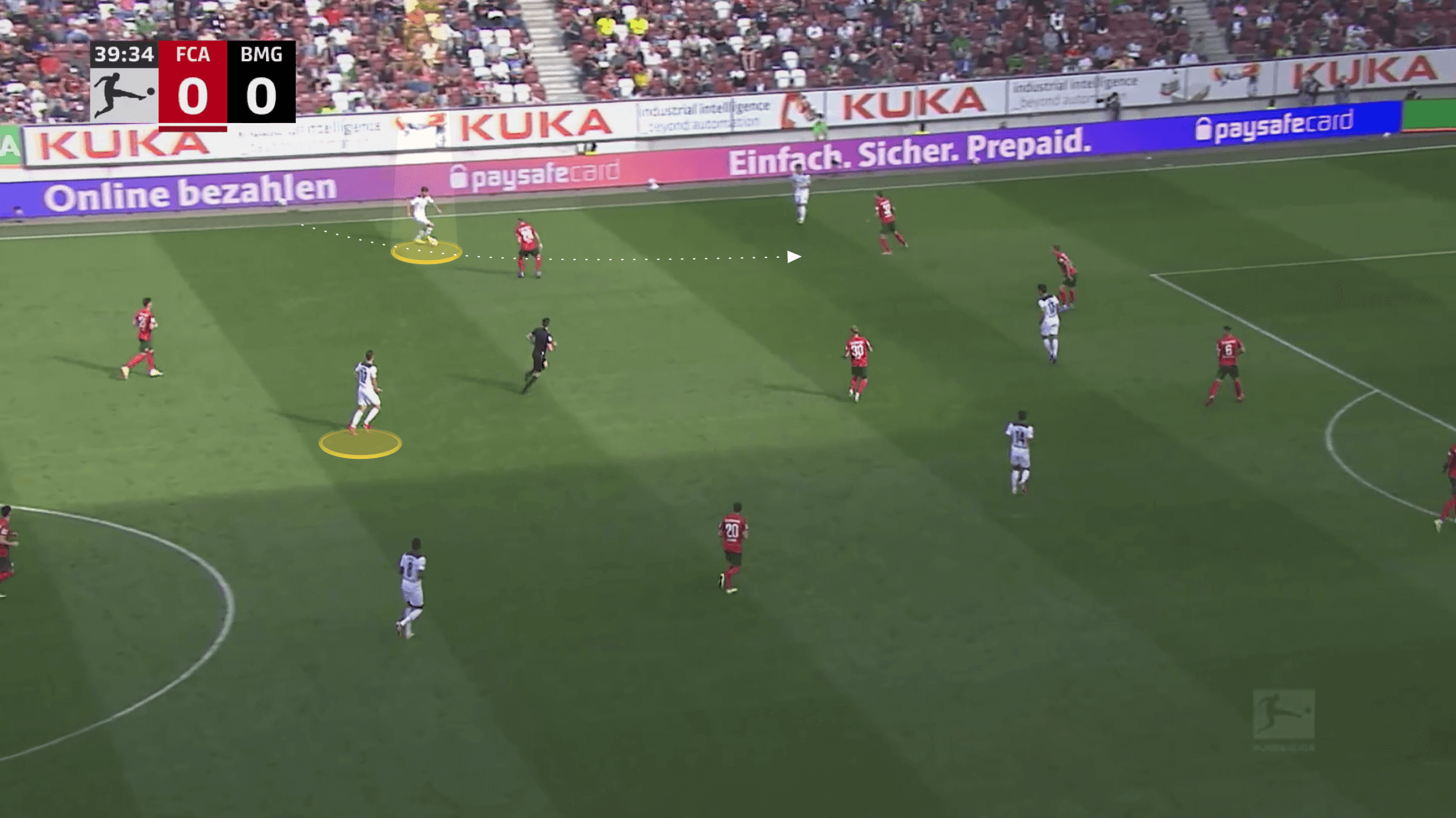
Scally has quick feet though and his scanning allows him to see oncoming pressure and dribble away effectively as he receives. In the next example, he once again receives on his back foot, before using his front foot to sharply accelerate away from the tackle of the oncoming defender.
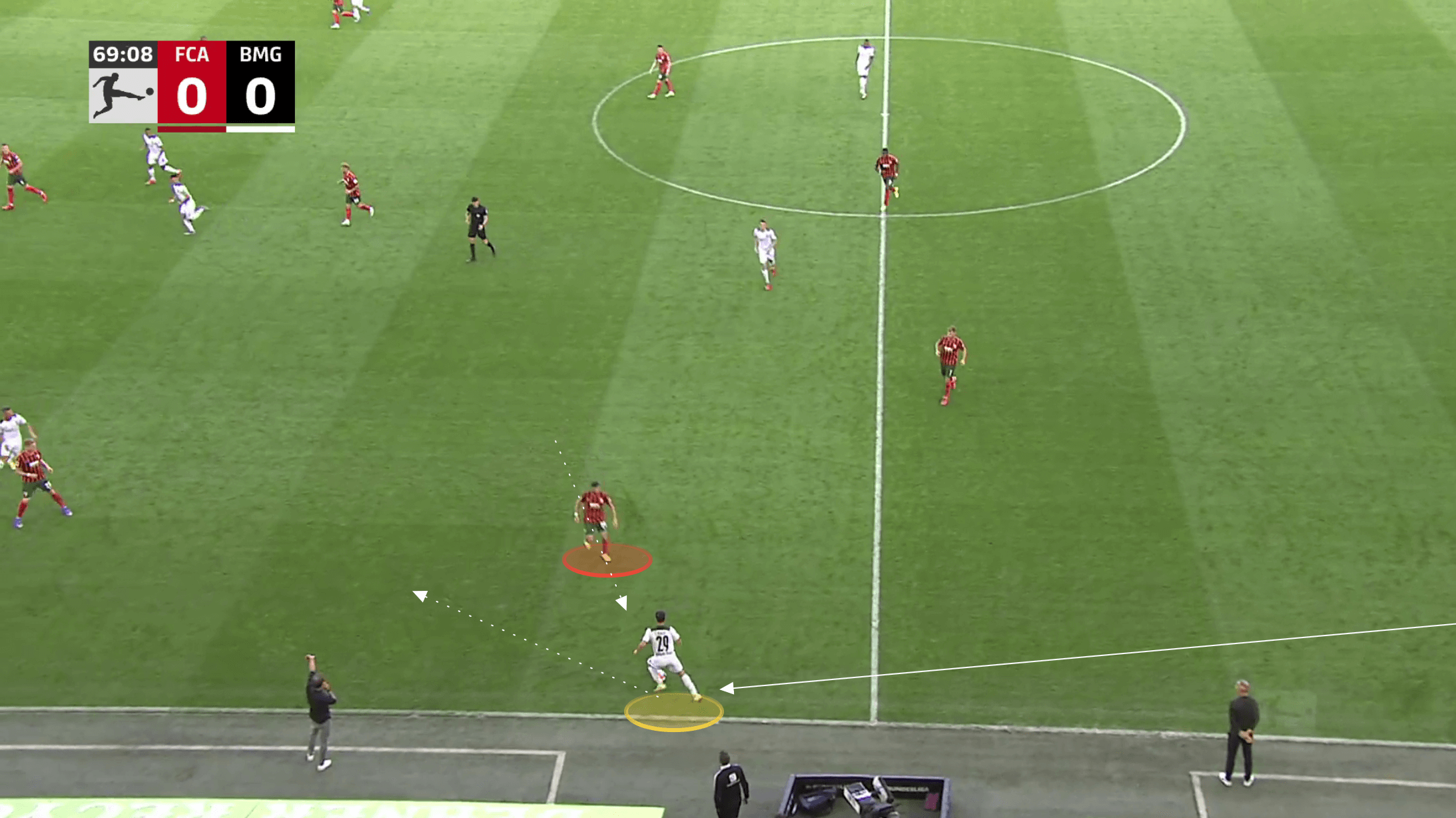
He then shows good decision-making to cut inside, getting his body between the defender and the ball, showing the opponent his back and allowing him to secure possession whilst continue to drive forward.
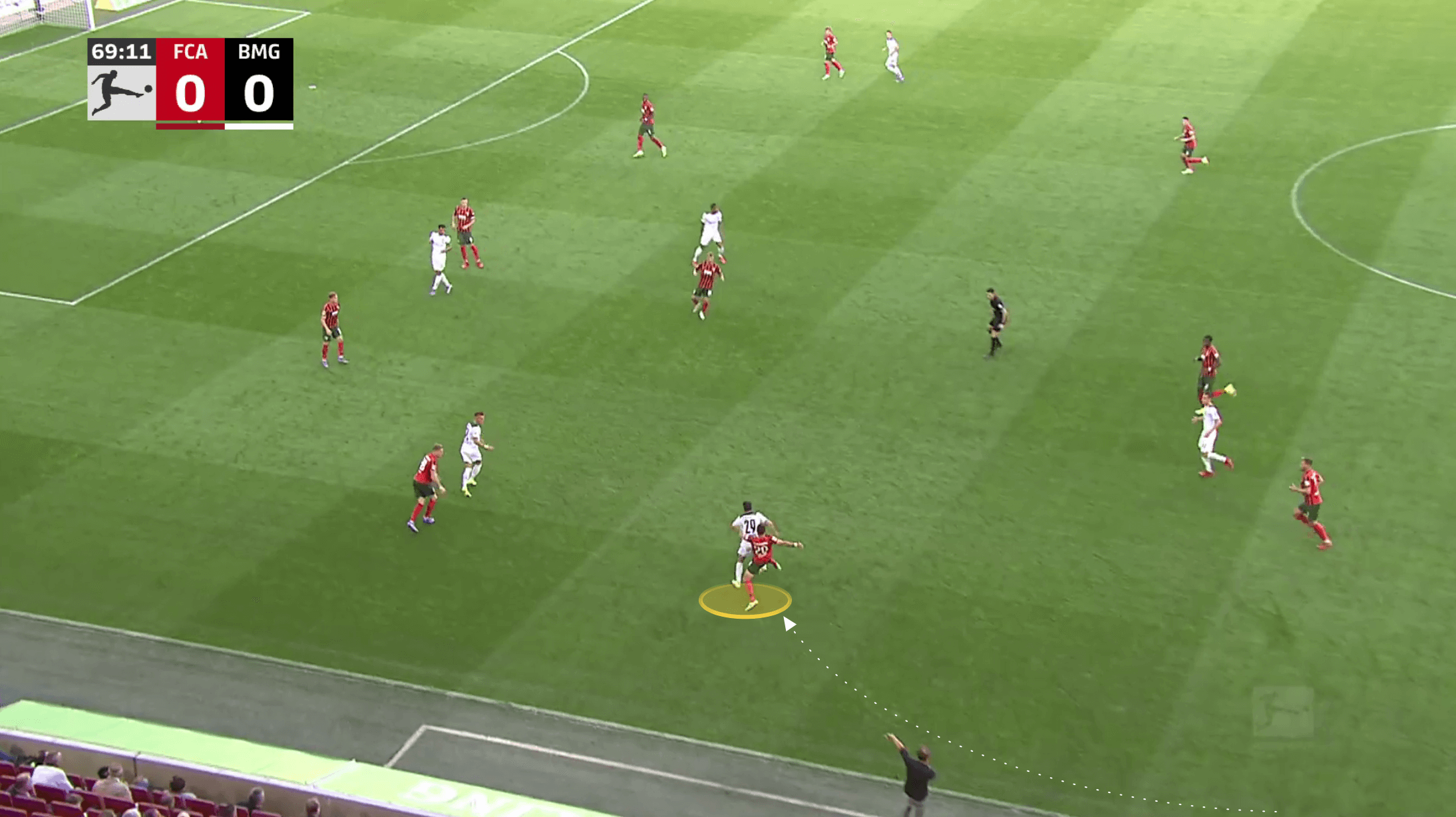
Conclusion
Scally has been a surprisingly good addition to Borussia Mönchengladbach’s squad and at just 18 years of age, he has plenty of potential to grow into an elite full-back, on either side. Fans of the USA men’s national team will be surprised that he’s been unable to break into the senior squad, despite looking utterly at ease in one of the best league’s in the world. His versatility will only benefit him at this stage of his career, where minutes are important, but as he develops he will likely want to specialise in one position, being a left-back, for example, who can play as a right-back.




Comments